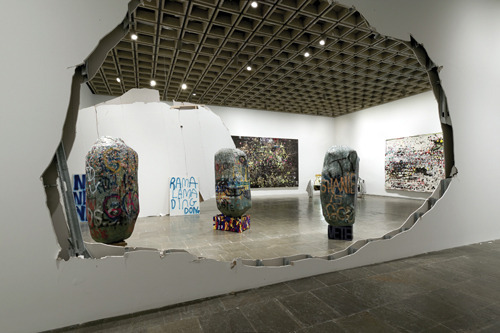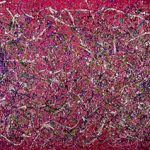Special Features: Course of Empire — The Biennial’s American Night
Installation view, Urs Fisher. The Intelligence of Flowers (2003-6)
The Whitney Biennial is arguably the most significant arbiter of what it means to be an American contemporary artist. Yet in the recently-opened incarnation of the exhibition, a generous amount of artists are included who were neither born in nor reside in the US. Has an era begun where every artist, regardless of nationality, is American?
The current Whitney Biennial, which opened on March 2, 2006, puts me in the mind, oddly enough, of John F. Kennedy’s famous speech in which he proclaimed, “Ich bin ein Berliner”—I am a Berliner. Uttered at the end of an oration delivered in June of 1963, less than a year after the Cuban Missile Crisis and months before Kennedy himself was assassinated, the phrase capped off a thesis supporting the partitioned West Berlin and, more specifically, Western capitalist democracy. Underscoring the postwar idea of a global citizen, he concluded not just that he was a Berliner, but that “all free men, wherever they may live, are citizens of Berlin.”
The Biennial, an exhibition historically devoted to new currents in American art, has taken to thinking like Kennedy. In the past, artists born abroad, but based in the US, were considered eligible; now artists who were not only born abroad, but who still live there, are included. The fallout of globalism (or, in the world of business and politics, “globalization”) means that we are all Berliners—or Americans—now. All artists, wherever they may live, are citizens of the United States.
What a moment to be an American! A pivotal moment in our nation’s history, since being an “American artist” means something markedly different than it did even a decade ago. It means, among other things, being implicated in all that has gone wrong, domestically and around the world. It means we’ve reached a point where foreigners need to explain what it is to be American, ergo the Biennial catalog excerpts from Bernard-Henri Lévy’s In the Footsteps of Tocqueville and Down by Law, a show-within-a-show (curated by the Wrong Gallery, whose principals are two-thirds Italian) which explores transgression in America, a nation that a both polices the world and behaves like a renegade.
It is truly Night in America, as the title of the exhibition would be if the 1973 Truffaut film from which it was borrowed (La nuit américaine) were not translated as “Day for Night,” although, it should be noted, Truffaut’s title technically refers to film scenes shot in daylight and filtered to look like night. Swiss artist Urs Fisher’s carved-out walls on the fourth floor, which greet visitors at the exhibition’s egress, seem like warning enough of this American night.
Not only do they allude to the current war in Iraq, with their bombed-out urban appearance, but, like much of the work on view, they echo the art of earlier epochs: Gordon Matta-Clark’s architectural interventions, but also Henri Cartier-Bresson’s famous photograph of boys playing in destroyed ruins during the Spanish Civil War, a photograph shot through a cratered wall.
Night also presides over French artist Pierre Huyghe’s film A Journey That Wasn’t. The New York portion of the film feels like a 9/11 recreation, shot in the eerily lit Wollman Rink in New York’s Central Park on a misty evening, with skyscrapers blinking in the dark background and rows of spectators staring into the fog like the audiences photographed at atomic bomb test sites. The other half of the film, shot in the white-out desolation of Antarctica, fulfills the film’s quest—“the desire of an elsewhere”—but also fits the vision of a futuristic post-apocalyptic landscape.
The fairy-tale escapism of the last Biennial has given way to the heaviness of history. One wants to follow the lead of Hannah Greeley’s Silencer, a sculpture of a diapered infant sticking its head under a jacket, an allegory of American shame. It has been remarked that the US is beginning to feel like Rome before the fall, an empire in decline, and decadence and the death of idols are everywhere here, from JP Munro’s painting of an orgy chamber to Adam McEwen’s celebrity obituaries. Even T. Kelly Mason and Diana Thater’s film reduces Bob Dylan’s iconic, subcultural “Subterranean Homesick Blues” to a backbeat for teenagers jumping rope. The only thing missing is Ed Ruscha’s Course of Empire cycle of paintings from the 2005 Venice Biennale, which were shown at the Whitney last fall alongside reproductions of Thomas Cole’s 19th century cycle of paintings entitled The Course of Empire.
But we have something else with which to address the question of empire, also shown previously at the Biennale: Francesco Vezzoli’s Trailer for a Remake of Gore Vidal’s “Caligula.” Vidal, of course, is an inspired choice: the greatest living writer of American historical fiction. In Vezzoli’s short film, a thinly veiled allegory of an empire “dominated by corrupt powers,” Vidal describes Caligula’s period as “a dark point in human history.” But he adds, “every point in human history is dark.”
This is, then, like the 1993 Biennial, a “political” Biennial. But the obvious fact is, they’re all political, whether they include socially conscious art, a high quotient of women and people of color, or figuratively stick their heads in the sand. This one, unlike the 2003 Biennial’s escapist “response” to 9/11, also feels like a response to the response: to American military actions; to the 2004 re-election of Bush and his Republican administration; to the fact that, as global citizens, none of this is merely an American problem anymore.
It is a politically “correct” Biennial, a knowing one, but a sad one, too. There are many examples of artists and collectives working against the reigning political grain, specifically Deep Dish Television Network, the Center for Land Use Interpretation, Critical Art Ensemble, and Mark di Suvero and Rirkrit Tiravanija, who recreated di Suvero’s 1966 Peace Tower.(Although, despite it’s bumper-sticker pronouncements of “Iraq Oil Hubris Hegemony,” “Vietiraqnam,” and “Don’t want no part in your Armageddon,” the current Peace Tower,ensconced in the museum’s courtyard, feels very different from descriptions of the original tower—more like a coddled, privileged teenager raging in his bedroom than a radical protesting in the streets.)
Even the art history cited evokes moments of doom, like Deep Dish Television Network’s remake of Picasso’s Guernica in the basement, with the grieving figures set against a background of stock market reports from Consolidated Trading, or Sturtevant’s claustrophobic Duchampian installation, in which coal bags (mimicking the famed 1938International Exhibition of Surrealism in Paris) lining the ceiling make it feel as if the sky were falling in. It might make one feel better, in ruminating on art and the tenuousness of empires, that this is what the ’40s felt like—or the ’50s in Europe, or the ’60s in America. Which brings us back to our historian, Vidal, and his friendly reminder: don’t feel bad; every point in human history is dark.
To be an American, or an empire, just isn’t what it used to be. The world since Kennedy has changed, such that, as Denis Johnson pointed out in his essay “An Anarchist’s Guide to Somalia,” the nation-state, “the twentieth-century geopolitical entity held together by the government’s monopoly on the use of force—it’s finished. The Kalashnikov rifle and the Stinger missile, and the world-wide dissemination of these weapons during the proxy conflicts of the Cold War, have changed things as much as the invention of gunpowder did in the 13th century,” such that “a determined Third-World people can now hold out against the greatest powers … even factions at war with one another can, with their left hand, as it were, stalemate the U.N. in its efforts to stop the fighting among them.” Or, as Deborah Eisenberg speculates in her new collection of short stories, Twilight of Superheroes, “superpowers are probably a feature of youth … or maybe they belonged to a loftier period of history,” one before 9/11, and “everyone had seen what those few men were able to do with the odds and ends in their pockets.”
Perhaps the two years separating the last Biennial and this one were needed to make these things clear. Or perhaps it’s taken this long to realize the obvious, as stated in Democracy Now’s video (part of the Deep Dish Television Network’s compilation of videos entitledShocking and Awful): that the West’s prosperity is built on cheap Mid-Eastern oil. Or the fact that, if the nation-state and this empire are entering their twilight, there’s no point in taking the pulse of “American” art, since, as Kennedy predicted, we’re all, either by birth or default or the fate of history, some sort of Americans.
Martha Schwendener is a Brooklyn-based writer and a frequent contributor to Artforum, Time Out New York, and The New Yorker.





